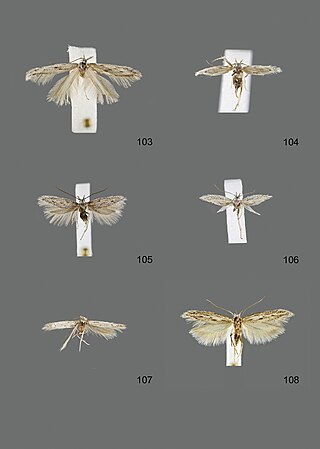
Megacraspedus is a genus of moths in the family Gelechiidae, found primarily in the Palearctic.
Megacraspedus litovalvellus is a moth of the family Gelechiidae. It is found in Russia. The habitat consists of chalk steppes.

Megacraspedus multispinella is a moth of the family Gelechiidae. It is found in Russia. The habitat consists of rocky steppe slopes with lush low vegetation.
Megacraspedus longipalpella is a moth of the family Gelechiidae. It is found in Russia. The habitat consists of grassy lowland steppes.
Megacraspedus attritellus is a moth of the family Gelechiidae. It is found in Russia and possibly Turkey.
Megacraspedus niphorrhoa is a moth of the family Gelechiidae. It is found in Russia and Kazakhstan (Uralsk).
Megacraspedus fallax is a moth of the family Gelechiidae. It is found in France, Spain, Hungary, southern Ukraine, Russia, the Caucasus and from Kazakhstan to north-western China.
Megacraspedus inficeta is a moth of the family Gelechiidae. It was described by Edward Meyrick in 1904. It is found in Australia, where it has been recorded from New South Wales and Tasmania.
Megacraspedus ischnota is a moth of the family Gelechiidae. It was described by Edward Meyrick in 1904. It is found in Australia, where it has been recorded from Western Australia.
Megacraspedus isotis is a moth of the family Gelechiidae. It was described by Edward Meyrick in 1904. It is found in Australia, where it has been recorded from Western Australia.
Megacraspedus pityritis is a moth of the family Gelechiidae. It was described by Edward Meyrick in 1904. It is found in Australia, where it has been recorded from southern Queensland, New South Wales, Victoria and Tasmania.
Megacraspedus popularis is a moth of the family Gelechiidae. It was described by Edward Meyrick in 1904. It is found in Australia, where it has been recorded from New South Wales and Tasmania.
Megacraspedus sematacma is a moth of the family Gelechiidae. It was described by Edward Meyrick in 1921. It is found in Australia, where it has been recorded from Queensland.
Megacraspedus serica is a moth of the family Gelechiidae. It was described by Edward Meyrick in 1909. It is found in South Africa.
Megacraspedus exilis is a moth of the family Gelechiidae. It was described by Walsingham in 1909. It is found in Mexico (Guerrero) and the southern United States, where it has been recorded from Texas.
Megacraspedus pentheres is a moth of the family Gelechiidae. It was described by Walsingham in 1920. It is found in southern France.
Megacraspedus pusillus is a moth of the family Gelechiidae. It was described by Walsingham in 1903. It is found in Spain.
Megacraspedus tristictus is a moth of the family Gelechiidae. It was described by Walsingham in 1910. It is found in southern France and Italy.
Megacraspedus niphodes is a moth of the family Gelechiidae. It was described by Oswald Bertram Lower in 1897. It is found in Australia, where it has been recorded from Victoria and Tasmania.
Megacraspedus sagittifera is a moth of the family Gelechiidae. It was described by Oswald Bertram Lower in 1900. It is found in Australia, where it has been recorded from New South Wales.

